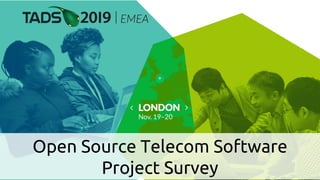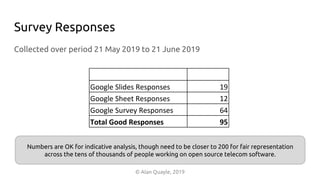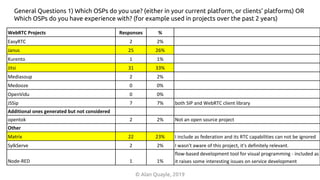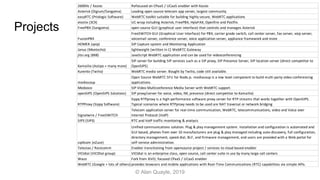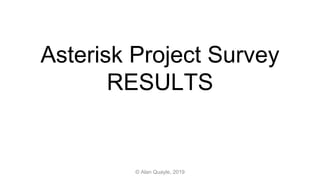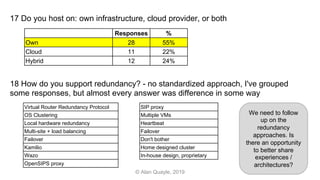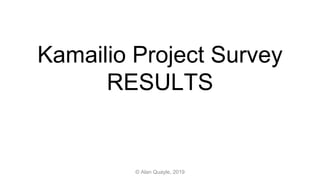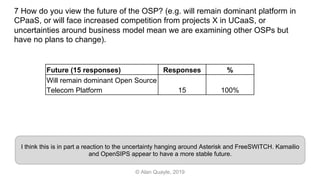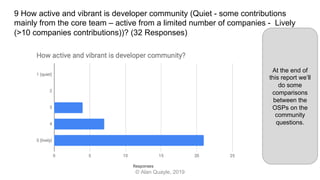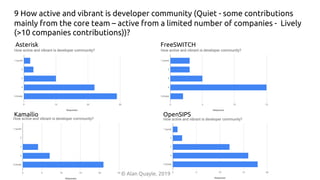TADSummit EMEA, Survey results on Open Source Telecom Software
- 1. Open Source Telecom Software Project Survey
- 2. • Gather across the industry people's experiences and opinions on using Open Source Telecom Software Projects (OSPs), and share an anonymized aggregate view of the different projects with those that complete the survey. • Weblog that introduced the survey • http://alanquayle.com/2019/05/open-source-telecom-software-project-survey/ • Why? I'm often asked to comment on the different projects, this is an attempt to provide something more authoritative than my opinions based on who I last talked to J © Alan Quayle, 2019 Purpose
- 3. • Overall numbers • Asterisk • FreeSWITCH • Kamailio • OpenSIPS • Mobicents/RESTCOMM • RTPproxy • FreePBX • PusionPBX • Janus • Jitsi • Kazoo © Alan Quayle, 2019 Outline • Sipcapture-homer • Vicidial • Wazo • Matrix • Node-Red • Comparative Analysis • A few take-aways
- 4. Survey Responses Collected over period 21 May 2019 to 21 June 2019 Google Slides Responses 19 Google Sheet Responses 12 Google Survey Responses 64 Total Good Responses 95 © Alan Quayle, 2019 Numbers are OK for indicative analysis, though need to be closer to 200 for fair representation across the tens of thousands of people working on open source telecom software.
- 5. General Questions 1) Which OSPs do you use? (either in your current platform, or clients’ platforms) OR Which OSPs do you have experience with? (for example used in projects over the past 2 years) Which OSPs do you use? Responses % Asterisk 71 75% FreeSWITCH 39 41% Kamailio 41 43% OpenSIPS 51 54% Restcomm/Mobicents 3 3% The only TAS we did not receive feedback from was SIPfoundry/sipxcom. I only recently made contacts there, likely my lack of credibility in that community meant it did not receive much attention. © Alan Quayle, 2019
- 6. General Questions 1) Which OSPs do you use? (either in your current platform, or clients’ platforms) OR Which OSPs do you have experience with? (for example used in projects over the past 2 years) Management Interfaces / Solution Wraps / Monitoring & Capture Responses % Elastix (for Asterisk) 1 1% FreePBX (for Asterisk) 21 22% FusionPBX (for FreeSwitch) 10 11% Kazoo 2 2% RTPProxy 18 19% SIP3 0 0% Sipcapture - Homer 31 33% Sippy Softswitch 2 2% VICIdial (for Asterisk) 7 7% Wazo (for Asterisk) 15 16% YETISwitch 0 0% sipsak, sipp 1 1% Note: sipsak is a CLI for testing using SIPp (Open Source test tool / traffic generator) © Alan Quayle, 2019 Nice to see RTPProxy being used, it comes up in discussions more often. Nice to see more niche projects like VICIdial being used. All these projects helps explain the diversity of application areas we see for open source projects. Even though Wazo is relatively new (it is a fork from XiVo), adoption is strong. It takes time for projects to be adopted in open source, stability and reliability are critical.
- 7. General Questions 1) Which OSPs do you use? (either in your current platform, or clients’ platforms) OR Which OSPs do you have experience with? (for example used in projects over the past 2 years) WebRTC Projects Responses % EasyRTC 2 2% Janus 25 26% Kurento 1 1% Jitsi 31 33% Mediasoup 2 2% Medooze 0 0% OpenVidu 0 0% JSSip 7 7% both SIP and WebRTC client library Additional ones generated but not considered opentok 2 2% Not an open source project Other Matrix 22 23% I include as federation and its RTC capabilities can not be ignored SylkServe 2 2% I wasn't aware of this project, it's definitely relevant. Node-RED 1 1% flow-based development tool for visual programming - included as it raises some interesting issues on service development © Alan Quayle, 2019
- 8. Projects © Alan Quayle, 2019 2600Hz / Kazoo Refocused on CPaaS / UCaaS enabler with Kazoo Asterisk (Digium/Sangoma) Leading open source telecom app server, largest community easyRTC (Priologic Software) WebRTC toolkit suitable for building highly secure, WebRTC applications elastix (3CX) UC wrap including Asterisk, FreePBX, HylaFAX, Openfire and Postfix. FreePBX (Sangoma) open source GUI (graphical user interface) that controls and manages Asterisk FusionPBX FreeSWITCH GUI (Graphical User Interface) for PBX, carrier grade switch, call center server, fax server, voip server, voicemail server, conference server, voice application server, appliance framework and more HOMER (qxip) SIP Capture system and Monitoring Application Janus (Meetecho) lightweight (written in C) WebRTC Gateway jitsi.org (8X8) JavaScript WebRTC application and can be used for videoconferencing Kamailio (Astipo + many more) SIP server for building SIP services such as a SIP proxy, SIP Presence Server, SIP location server (direct competitor to OpenSIPS) Kurento (Twilio) WebRTC media server. Bought by Twilio, code still available. mediasoup Open Source WebRTC SFU for Node.js. mediasoup is a low level component to build multi-party video conferencing applications. Medooze SIP Video Multiconference Media Server with WebRTC support. openSIPS (OpenSIPS Solutions) SIP proxy/server for voice, video, IM, presence (direct competitor to Kamailio) RTPProxy (Sippy Software) Sippy RTPproxy is a high-performance software proxy server for RTP streams that works together with OpenSIPS. Typical scenarios where RTPproxy needs to be used are NAT traversal or network bridging Signalwire / FreeSWITCH Telecom application server for real-time communication, WebRTC, telecommunications, video and Voice over Internet Protocol (VoIP) SIP3 (SIP3) RTC and VoIP traffic monitoring & analysis sipXcom (eZuce) Unified communications solution. Plug & play management system. Installation and configuration is automated and GUI based, phones from over 10 manufacturers are plug & play managed including auto-discovery, full configuration, directory management, speed dial, BLF, and firmware management, and users are provided with a Web portal for self-service administration. Telestax / Restcomm Enabler transitioning from opensource project / services to cloud based enabler VICIdial (VICIDial group) VICIdial is an enterprise class, open source, call center suite in use by many large call centers Wazo Fork from XiVO, focused CPaaS / UCaaS enabler WebRTC (Google + lots of others) provides browsers and mobile applications with Real-Time Communications (RTC) capabilities via simple APIs.
- 9. Asterisk Project Survey RESULTS © Alan Quayle, 2019
- 10. 5 What is the main application(s) / market need(s)? (PBX, Conferencing, Contact Center, Mobile App Comms, CPaaS, UCaaS, CCaaS, PBX, video CC, what is the scale of the implementation (100, 1000, 10k, 100k, 1M+)) Application (66 responses) Responses % PBX 50 76% Conferencing 28 42% Contact Center 37 56% Mobile App Comms 6 9% CPaaS 4 6% UCaaS 7 11% CCaaS 0 0% Video CC 0 0% Media App Server 6 9% Scale (66 responses) Responses % 100 22 33% 1000 12 18% 10k 25 38% 100k 11 17% 1M+ 3 5% © Alan Quayle, 2019 The “popular” view: Asterisk is used for PBX implementations at enterprise scale. This provides some quantification on the breadth and scale of Asterisk applications.
- 11. 6 What to you consider the strengths and weaknesses of the OSP? Strengths 41 responses % Features 8 20% Reliability 15 37% Openness 3 7% Flexibility 14 34% Community 17 41% Maturity 10 24% Easy to set-up / configure 9 22% Small footprint 8 20% Well documented 3 7% Weaknesses 33 results % Uncertainty over new ownership 5 15% IPPBX centric 8 24% Cloud support 7 21% Multi-tenancy 6 18% Scalability 9 27% Performance 4 12% Direction from Community 4 12% © Alan Quayle, 2019 Community, Reliability and Flexibility are top features. A correlation on the weaknesses is those highlighting scalability, IPPBX-centric, cloud support, were NOT providing feedback on the solution wraps / management interfaces.
- 12. 7 How do you view the future of the OSP? (e.g. will remain dominant platform in CPaaS, or will face increased competition from projects X in UCaaS, or uncertainties around business model mean we are examining other OSPs but have no plans to change). Future (33 responses) Responses % Will remain dominant IPPBX / remains dominant project 19 58% Depends on Sangoma 8 24% Unknown / not sure 6 18% © Alan Quayle, 2019 Astricon (Oct 29-30) is going to be interesting, see you there!
- 13. 9 How active and vibrant is developer community (Quiet - some contributions mainly from the core team – active from a limited number of companies - Lively (>10 companies contributions))? (66 Responses) © Alan Quayle, 2019 At the end of this report we’ll do some comparisons between the OSPs on the community questions.
- 14. 13 Do you find it easy to hire knowledgeable consultants, or otherwise access operational support for the platform from outside your immediate organization (easy – OK - hard) (59 Responses) © Alan Quayle, 2019 We’ll add geographic focus on the next revision of the survey as I think the spread in knowledgeable consultants is in part linked to this. From my experience its expertise in multiple projects, e.g. Kamailio, OpenSIPS, Asterisk, FreeSWITCH and others…
- 15. 15 How do you architect your deployments (choices not exclusive and multi- dimensional) Responses % Container Images 14 22% Container Orchestration 9 14% VM Images 48 75% Bare Metal 41 64% 16 Do you use a configuration management/scripting system like Chef, Puppet, Ansible, SaltStack, Terraform or CloudFormation etc. Responses % none 4 8% own / in-house 8 15% SaltStack 2 4% Ansible 29 56% Pupper 9 17% © Alan Quayle, 2019 Bare Metal, Ansible and Self Hosted (see next slide) - This is not a party for AWS and Google J
- 16. 17 Do you host on: own infrastructure, cloud provider, or both Responses % Own 28 55% Cloud 11 22% Hybrid 12 24% 18 How do you support redundancy? - no standardized approach, I've grouped some responses, but almost every answer was difference in some way Virtual Router Redundancy Protocol OS Clustering Local hardware redundancy Multi-site + load balancing Failover Kamilio Wazo OpenSIPS proxy SIP proxy Multiple VMs Heartbeat Failover Don't bother Home designed cluster In-house design, proprietary © Alan Quayle, 2019 We need to follow up on the redundancy approaches. Is there an opportunity to better share experiences / architectures?
- 17. Kamailio Project Survey RESULTS © Alan Quayle, 2019
- 18. 5 What is the main application(s) / market need(s)? (PBX, Conferencing, Contact Center, Mobile App Comms, CPaaS, UCaaS, CCaaS, PBX, video CC, what is the scale of the implementation (100, 1000, 10k, 100k, 1M+)) Application (40 responses) Responses % PBX 17 43% Conferencing 8 20% Contact Center 9 23% Mobile App Comms 8 20% CPaaS 13 33% UCaaS 12 30% SBC 2 5% Class 5 termination 3 8% Class 4 telco interconnect 3 8% CCaaS 3 8% Call routing / SIP routing 9 23% Header manipulation 2 5% Video CC 1 3% Scale (38 responses) Responses % 100 0 0% 1000 13 34% 10k 14 37% 100k 10 26% 1M+ 15 39% © Alan Quayle, 2019 Broad base of projects with a slight bias to large scale deployments, which jives with my discussions on implementations where Kamailio is used as the front-end with multiple Asterisk or FreeSWITCH applications servers on the backend.
- 19. 6 What to you consider the strengths and weaknesses of the OSP? Strengths (34 Responses) Responses % Performance 12 35% Community 11 32% Modularity 2 6% Available Modules 3 9% Flexible / Extensible / Open 12 35% Secure 2 6% Lightweight 3 9% Stability 11 32% Scalability 6 18% Weaknesses (6 Responses) Responses % Documentation is tough for newcomers 4 67% Can be tough to configure 3 50% © Alan Quayle, 2019 Strengths in Performance, Community, Flexibility, and Stability. Weaknesses are well- known, “You’ve got to know what you’re doing.”
- 20. 7 How do you view the future of the OSP? (e.g. will remain dominant platform in CPaaS, or will face increased competition from projects X in UCaaS, or uncertainties around business model mean we are examining other OSPs but have no plans to change). Future (15 responses) Responses % Will remain dominant Open Source Telecom Platform 15 100% © Alan Quayle, 2019 I think this is in part a reaction to the uncertainty hanging around Asterisk and FreeSWITCH. Kamailio and OpenSIPS appear to have a more stable future.
- 21. 8 What client protocol/interface/platform do you use to connect OSP, e.g. SIP.js, JsSIP, sipML5, other SIP SDK, other in browser signaling (like raw JSON over WebSockets) + WebRTC? Client (26 responses) Response s % SIP.js 11 42% JsSIP 4 15% SipML5 0 0% Other SIP SDK 12 46% In browser signaling 9 35% WebRTC 9 35% SIP phones / hard phones 0 0% Custom / in-house 5 19% © Alan Quayle, 2019 We need to investigate what is used in “Other SIP SDK” in the next survey.
- 22. 9 How active and vibrant is developer community (Quiet - some contributions mainly from the core team – active from a limited number of companies - Lively (>10 companies contributions))? (32 Responses) © Alan Quayle, 2019 At the end of this report we’ll do some comparisons between the OSPs on the community questions.
- 23. 10 Does the developer community make itself accessible for participation (closed – OK – Open (with lots of fast help (hours) and dev events))? (32 Responses) © Alan Quayle, 2019
- 24. 11 How easy is it to engage with the community on features/issues that are important to you? (difficult (no/slow response) – OK (responses can take days) – good (rapid response, within hours, day max)) (28 Responses) © Alan Quayle, 2019
- 25. 12 If you develop and enhance the platform yourself, how open do you find the community to your submissions and pull requests? (closed – OK – welcoming) (26 Responses) © Alan Quayle, 2019 The love is strong for Kamailio J
- 26. 13 Do you find it easy to hire knowledgeable consultants, or otherwise access operational support for the platform from outside your immediate organization (easy – OK - hard) (29 Responses) © Alan Quayle, 2019 We’ll add geographic focus on the next revision of the survey as I think the spread in knowledgeable consultants is in part linked to this.
- 27. 15 How do you architect your deployments (choices not exclusive and multi- dimensional) (31 Responses) 16 Do you use a configuration management/scripting system like Chef, Puppet, Ansible, SaltStack, Terraform or CloudFormation etc. (26 Responses) Responses % Container Images 6 19% Container Orchestration 8 26% VM Images 24 77% Bare Metal 19 61% Responses % own / in-house 5 19% Ansible 19 73% Pupper 7 27% Terraform 3 12% Packer 1 4% © Alan Quayle, 2019 Bare Metal, Ansible and Self Hosted (see next slide) - This is not a party for AWS and Google J
- 28. 17 Do you host on: own infrastructure, cloud provider, or both (23 Responses) 18 How do you support redundancy? - no standardized approach, I've grouped some responses, but almost every answer was difference in some way (23 Responses) Responses % Own 14 61% Cloud 5 22% Hybrid 6 26% Redundancy (23 responses) - no standardized approach, I've grouped some responses, but almost every answer was difference, except 'don't bother' Local hardware redundancy Multi-site + load balancing HA pairs, clusters, and global redundancy Don't bother Redis state replication In-house design, proprietary SIP proxies AWS + HAProxy for WebSockets Different az and region setup within AWS, managed database with inbuilt redundancy Pacemaker, Corosync Redundant across 3 availability zones and two regions Mostly multi-master on many layers, trying to follow eventual consistency on data storage layer© Alan Quayle, 2019
- 29. Some Comparisons from Project Survey RESULTS © Alan Quayle, 2019
- 30. 9 How active and vibrant is developer community (Quiet - some contributions mainly from the core team – active from a limited number of companies - Lively (>10 companies contributions))? Asterisk FreeSWITCH Kamailio OpenSIPS © Alan Quayle, 2019
- 31. 10 Does the developer community make itself accessible for participation (closed – OK – Open (with lots of fast help (hours) and dev events))? Asterisk FreeSWITCH Kamailio OpenSIPS © Alan Quayle, 2019
- 32. 11 How easy is it to engage with the community on features/issues that are important to you? (difficult (no/slow response) – OK (responses can take days) – good (rapid response, within hours, day max)) Asterisk FreeSWITCH Kamailio OpenSIPS © Alan Quayle, 2019
- 33. 12 If you develop and enhance the platform yourself, how open do you find the community to your submissions and pull requests? (closed – OK – welcoming) Asterisk FreeSWITCH Kamailio OpenSIPS © Alan Quayle, 2019
- 34. 13 Do you find it easy to hire knowledgeable consultants, or otherwise access operational support for the platform from outside your immediate organization (easy – OK - hard) Asterisk FreeSWITCH Kamailio OpenSIPS © Alan Quayle, 2019
- 35. A Few Take-Aways ● For configuration management / scripting, the answer is Ansible ○ Should each project share popular scripts to aid adoption and setup? ● Native Cloud (AWS, Google, etc.) is not a popular choice ● Geography ○ Some in Europe were surprised at the size of the Asterisk responses, it would be interesting to map how the projects are adopted around the world ● There’s still much we can do together as a global community to accelerate open source adoption © Alan Quayle, 2019
- 36. Next Steps ● Survey ended up being long…. ● Suggest we focus and have a couple of surveys to focus on aspects people find important ● Looking for guidance… © Alan Quayle, 2019
- 37. Standing on the Shoulders of Giants.. Bernard of Chartres in 12C Isaac Newton in 1675 ..we can focus on the customer Open Source Telecom Software

